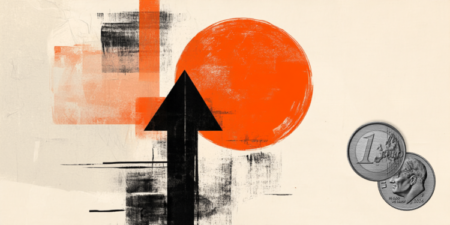- The Japanese Yen attracts some buyers on Tuesday, though it lacks follow-through.
- Concerns that Trump’s tariffs would impact Japan’s industries cap gains for the JPY.
- The divergent BoJ-Fed expectations favor USD/JPY bears amid subdued USD demand.
The Japanese Yen (JPY) trades with a mild positive bias against its American counterpart through the Asian session on Tuesday, though it lacks bullish conviction. The Bank of Japan’s (BoJ) Tankan survey released today showed that Japanese enterprises raised their inflation forecasts for one year, three years, and five years ahead. This comes on strong consumer inflation figures from Tokyo – Japan’s national capital – and backs the case for more rate increases from the BoJ and turns out to be a key factor lending support to the JPY.
However, a positive turnaround in the global risk sentiment – as depicted by a generally positive tone around the equity markets – cap any further gains for the safe-haven JPY. Furthermore, receding expectations that the BoJ would raise the policy rate at a faster pace, amid worries about an economic slowdown on the back of US tariffs, act as a headwind for the JPY. However, the recent narrowing of the rate differential between Japan and other countries suggests that the path of least resistance for the lower-yielding JPY remains to the upside.
Japanese Yen bulls seem non-committed amid trade-related uncertainties
- The Bank of Japan’s Tankan survey released earlier this Tuesday showed that business confidence at large manufacturers in Japan eased in the first quarter (Q1) of 2025. The headline large Manufacturers’ Sentiment Index came in at 12.0 in Q1 from the previous reading of 14.0, in line with consensus estimates. Additional details revealed that the large Manufacturing Outlook for the first quarter arrived at 12.0 versus 13.0 prior and the 9.0 expected.
- Furthermore, Japanese enterprises projected consumer prices to rise 2.5% in one year and 2.4% in three years versus 2.4% and 2.3% increase, respectively, in the prior survey. They also forecast inflation to rise 2.3% in five years compared to a 2.2% increase in the prior survey. This comes on top of Friday’s strong consumer inflation figures from Tokyo – Japan’s capital city – and reaffirms bets that the BoJ might continue raising interest rates in 2025.
- US President Donald Trump last week unveiled a 25% tariff on imported cars and will announce reciprocal tariffs later today, at 19:00 GMT. Investors remain worried that the new levies would have a far-reaching impact on Japan’s key industries and force the BoJ to keep the policy steady for the time being. Apart from this, a positive tone around the Asian equity markets might hold traders from placing bullish bets around the safe-haven Japanese Yen.
- The US Dollar, on the other hand, continues with its struggle to attract any meaningful buyers amid concerns that Trump’s trade tariffs would dent economic growth. Furthermore, the global flight to safety and expectations of multiple rate cuts from the Federal Reserve drag the US Treasury bond yields lower. The resultant narrowing of the US-Japan rate differential lends additional support to the lower-yielding JPY during the Asian session on Tuesday.
- Traders now look forward to this week’s important US macro releases, scheduled at the beginning of a new month, starting with the JOLTS openings and ISM Manufacturing PMI on Tuesday. This will be followed by the ADP report on Wednesday, the US ISM Services PMI on Thursday, and the closely-watched US Nonfarm Payrolls (NFP) on Friday. This will play a key role in influencing the USD and provide some meaningful impetus to the USD/JPY pair.
USD/JPY seems vulnerable amid the overnight ascending channel breakdown
From a technical perspective, the overnight breakdown below the lower end of a multi-week-old ascending trend channel was seen as a key trigger for the USD/JPY bears. However, neutral oscillators on the daily chart and the overnight resilience below the 100-period Simple Moving Average (SMA) on the daily chart warrant caution before positioning for further losses. Hence, any subsequent slide could find some support near the 149.00 mark ahead of the overnight swing low, around the 148.70 area. Some follow-through selling will reaffirm the negative bias and make spot prices vulnerable to resuming a well-established downtrend witnessed over the past three months or so.
On the flip side, momentum beyond the previous day’s peak, around the 150.25 area, could lift the USD/JPY pair beyond the 150.75-150.80 hurdle and allow bulls to reclaim the 151.00 mark. This is followed by the March monthly swing high, around the 151.30 region and a technically significant 200-day SMA, currently pegged near the 151.60 zone. A sustained strength beyond the latter might shift the bias in favor of bulls and lift the pair to the 152.00 mark en route to the 152.45-152.50 region and the 100-day SMA, around the 153.00 round figure.
Japanese Yen FAQs
The Japanese Yen (JPY) is one of the world’s most traded currencies. Its value is broadly determined by the performance of the Japanese economy, but more specifically by the Bank of Japan’s policy, the differential between Japanese and US bond yields, or risk sentiment among traders, among other factors.
One of the Bank of Japan’s mandates is currency control, so its moves are key for the Yen. The BoJ has directly intervened in currency markets sometimes, generally to lower the value of the Yen, although it refrains from doing it often due to political concerns of its main trading partners. The BoJ ultra-loose monetary policy between 2013 and 2024 caused the Yen to depreciate against its main currency peers due to an increasing policy divergence between the Bank of Japan and other main central banks. More recently, the gradually unwinding of this ultra-loose policy has given some support to the Yen.
Over the last decade, the BoJ’s stance of sticking to ultra-loose monetary policy has led to a widening policy divergence with other central banks, particularly with the US Federal Reserve. This supported a widening of the differential between the 10-year US and Japanese bonds, which favored the US Dollar against the Japanese Yen. The BoJ decision in 2024 to gradually abandon the ultra-loose policy, coupled with interest-rate cuts in other major central banks, is narrowing this differential.
The Japanese Yen is often seen as a safe-haven investment. This means that in times of market stress, investors are more likely to put their money in the Japanese currency due to its supposed reliability and stability. Turbulent times are likely to strengthen the Yen’s value against other currencies seen as more risky to invest in.
Read the full article here
















